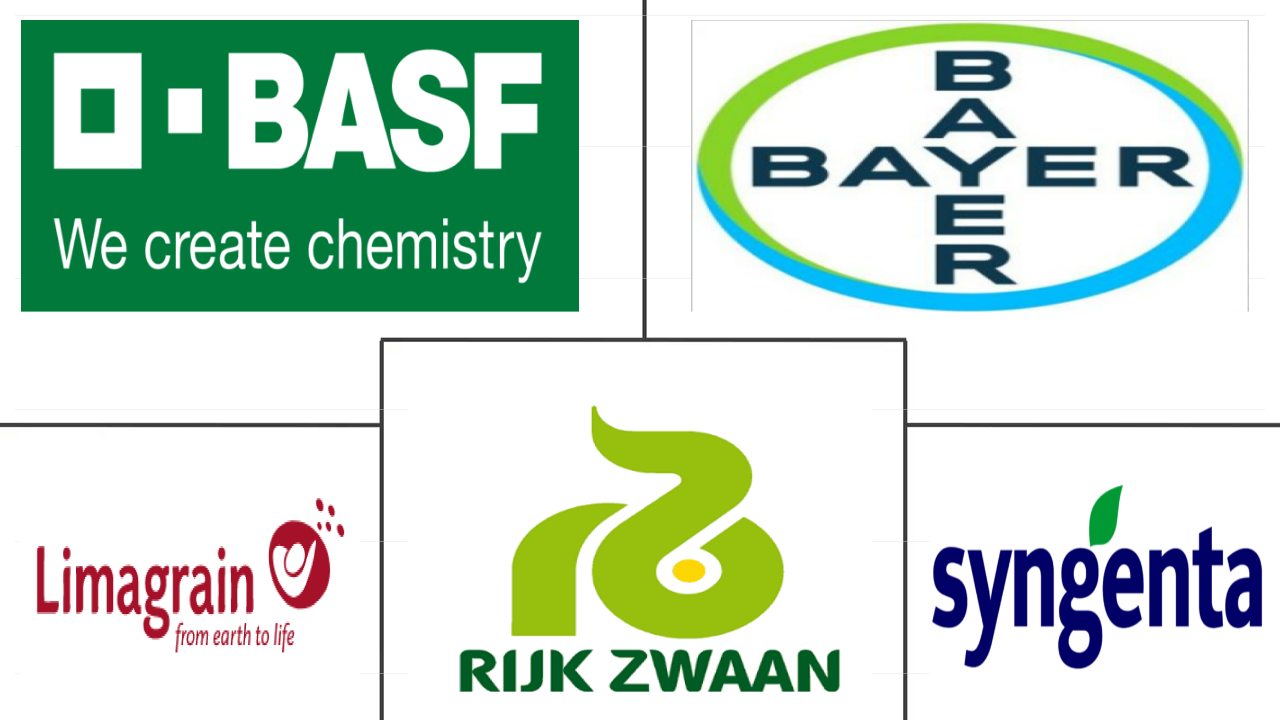Market Size of south america vegetable seed Industry
|
|
Study Period | 2017 - 2030 |
|
|
Market Size (2024) | USD 542.8 Million |
|
|
Market Size (2030) | USD 708 Million |
|
|
Largest Share by Breeding Technology | Hybrids |
|
|
CAGR (2024 - 2030) | 4.53 % |
|
|
Largest Share by Country | Brazil |
Major Players |
||

|
||
|
*Disclaimer: Major Players sorted in no particular order |
South America Vegetable Seed Market Analysis
The South America Vegetable Seed Market size is estimated at 542.8 million USD in 2024, and is expected to reach 708 million USD by 2030, growing at a CAGR of 4.53% during the forecast period (2024-2030).
542.8 Million
Market Size in 2024 (USD)
708 Million
Market Size in 2030 (USD)
2.70 %
CAGR (2017-2023)
4.53 %
CAGR (2024-2030)
Largest Market by Crop Family
17.49 %
value share, Solanaceae, 2023
It is the largest segment due to increased domestic demand and rising demand from the processing industries for these solanaceae crops, particularly tomatoes.
Largest Market by Country
35.47 %
value share, Brazil, 2023
Brazil dominates the market due to its highest area under vegetable cultivation in the region and the usage of a high percentage of hybrids to achieve higher productivity.
Fastest-growing Market by Crop Family
4.41 %
Projected CAGR, Brassicas, 2024-2030
The fastest growth of the segment is driven by an increase in the consumption of salad, short-duration crops suitable for protected cultivation, and high export value.
Fastest-growing Market by Country
5.14 %
Projected CAGR, Brazil, 2024-2030
Brazil is the leading producer of vegetables in the region, with favorable weather conditions and prices, which led to an increase in cultivation.
Leading Market Player
40.50 %
market share, Groupe Limagrain, 2022

It is the market leader, with a diversified vegetable seed portfolio with advanced research centers, processing units, and production factories in different locations.
Hybrids dominate the South American seed market due to their high usage in protected cultivation and their ability to produce high yields consistently
- In 2022, hybrids accounted for the major share compared to open-pollinated varieties, with a value of USD 361.4 million in 2022 in the South American vegetable seed market because the demand for hybrid seeds is high due to benefits such as drought tolerance, adaptability to the soil, and higher yield than open-pollinated seed varieties.
- The hybrids segment is estimated to register a CAGR of 9.1% during the forecast period because of the increase in the usage by farmers, companies providing new hybrid seed varieties, and benefits such as resistance to diseases, weather conditions, and pest attacks.
- The cultivation area of vegetables using hybrid seeds has increased from 627.3 thousand ha in 2017 to 695.4 thousand ha in 2022 because of the high usage of hybrids in crops such as tomatoes, garlic, and lettuce.
- In protected cultivation, the share of hybrid seeds was 100% because OPVs cannot be used in protected cultivation due to limitations such as the required insects or pests to be pollinated naturally; in protected cultivation, there is no natural pollination.
- Major companies, such as Syngenta, Rijk Zwaan Zaadteelt en Zaadhandel BV, and Enza Zaden, are also focused on providing improved hybrid seed varieties that are tolerant to viral diseases and are resistant to boltings and mildews.
- Open-pollinated seed varieties are used by small-scale farmers because of the low prices of seed, helping save input costs, but the crop damage is high as pests can attack the crop. This is expected to be a restraint in the growth of open-pollinated seed varieties during the forecast period.
- Therefore, the sales of hybrid seeds are estimated to increase during the forecast period due to benefits such as higher yield and the production of high-quality vegetables.
Brazil dominated the market with a higher area under cultivation
- In 2022, South America's share in the global vegetable seed market was about 6.9% because Chile is a leading exporter of seeds, has favorable weather conditions, and has a high demand for domestic and global vegetables.
- The cultivation area for vegetables increased from 5.2 million ha in 2018 to 5.3 million ha in 2022 because of the increase in the demand for vegetables and high prices, leading to high profits. Therefore, more seeds are expected to be required for cultivation during the forecast period.
- Brazil is the major country in the region, which accounted for 35.5% of the market share in 2022. The cultivation area of vegetables in Brazil increased by 1.2% from 2019 to 2022 because of the demand for vegetables for different types of salads, high-value crops, and high return on investment. Therefore, sales of vegetable seeds in the country are projected to increase during the forecast period.
- Argentina is the second major country in the region. The cultivation area of vegetables in Argentina increased from 0.19 million ha in 2017 to 0.2 million ha in 2022. The increase in cultivation area was due to different initiatives by the government and high-value crops. Therefore, sales of vegetable seeds are estimated to increase during the forecast period.
- The Rest of South America is expected to register a CAGR of 4.07% from 2023 to 2030 because of favorable weather conditions for different vegetable crops, especially tomatoes, onions, and potatoes.
- Therefore, factors such as an increase in the cultivation area, new technological advancements, and high demand for vegetables are expected to fuel the growth of the South American vegetable seed market during the forecast period.
South America Vegetable Seed Industry Segmentation
Hybrids, Open Pollinated Varieties & Hybrid Derivatives are covered as segments by Breeding Technology. Open Field, Protected Cultivation are covered as segments by Cultivation Mechanism. Brassicas, Cucurbits, Roots & Bulbs, Solanaceae, Unclassified Vegetables are covered as segments by Crop Family. Argentina, Brazil are covered as segments by Country.
- In 2022, hybrids accounted for the major share compared to open-pollinated varieties, with a value of USD 361.4 million in 2022 in the South American vegetable seed market because the demand for hybrid seeds is high due to benefits such as drought tolerance, adaptability to the soil, and higher yield than open-pollinated seed varieties.
- The hybrids segment is estimated to register a CAGR of 9.1% during the forecast period because of the increase in the usage by farmers, companies providing new hybrid seed varieties, and benefits such as resistance to diseases, weather conditions, and pest attacks.
- The cultivation area of vegetables using hybrid seeds has increased from 627.3 thousand ha in 2017 to 695.4 thousand ha in 2022 because of the high usage of hybrids in crops such as tomatoes, garlic, and lettuce.
- In protected cultivation, the share of hybrid seeds was 100% because OPVs cannot be used in protected cultivation due to limitations such as the required insects or pests to be pollinated naturally; in protected cultivation, there is no natural pollination.
- Major companies, such as Syngenta, Rijk Zwaan Zaadteelt en Zaadhandel BV, and Enza Zaden, are also focused on providing improved hybrid seed varieties that are tolerant to viral diseases and are resistant to boltings and mildews.
- Open-pollinated seed varieties are used by small-scale farmers because of the low prices of seed, helping save input costs, but the crop damage is high as pests can attack the crop. This is expected to be a restraint in the growth of open-pollinated seed varieties during the forecast period.
- Therefore, the sales of hybrid seeds are estimated to increase during the forecast period due to benefits such as higher yield and the production of high-quality vegetables.
| Breeding Technology | |
| Hybrids | |
| Open Pollinated Varieties & Hybrid Derivatives |
| Cultivation Mechanism | |
| Open Field | |
| Protected Cultivation |
| Crop Family | ||||||||
| ||||||||
| ||||||||
| ||||||||
| ||||||||
|
| Country | |
| Argentina | |
| Brazil | |
| Rest of South America |
South America Vegetable Seed Market Size Summary
The South America vegetable seed market is experiencing a steady growth trajectory, driven by the increasing demand for hybrid seeds due to their advantages such as drought tolerance, adaptability, and higher yields compared to open-pollinated varieties. The market is characterized by a significant shift towards hybrid seeds, which are gaining popularity among farmers for their resistance to diseases, weather conditions, and pest attacks. This trend is supported by major companies like Syngenta, Rijk Zwaan, and Enza Zaden, which are focusing on developing improved hybrid seed varieties. The region's vegetable cultivation area is expanding, particularly in Brazil and Argentina, due to the rising demand for high-value crops and government initiatives. However, the adoption of protected cultivation techniques is leading to a reduction in the overall vegetable cultivation area, as these methods offer higher yields in smaller spaces.
South America holds a notable position in the global vegetable seed market, with Brazil being the leading producer in the region. The market is fairly consolidated, with major players such as BASF SE, Bayer AG, Groupe Limagrain, Rijk Zwaan Zaadteelt en Zaadhandel BV, and Syngenta Group dominating the landscape. The demand for high-quality vegetables with disease-resistant traits and extended shelf life is driving the market forward, as farmers seek to meet both domestic and international market demands. The introduction of new seed varieties and strategic acquisitions by companies like Enza Zaden are further enhancing the market's growth prospects. As the region continues to adapt to changing agricultural practices and consumer preferences, the vegetable seed market is poised for continued expansion in the coming years.
South America Vegetable Seed Market Size - Table of Contents
-
1. MARKET SEGMENTATION (includes market size in Value in USD, Forecasts up to 2030 and analysis of growth prospects)
-
1.1 Breeding Technology
-
1.1.1 Hybrids
-
1.1.2 Open Pollinated Varieties & Hybrid Derivatives
-
-
1.2 Cultivation Mechanism
-
1.2.1 Open Field
-
1.2.2 Protected Cultivation
-
-
1.3 Crop Family
-
1.3.1 Brassicas
-
1.3.1.1 Cabbage
-
1.3.1.2 Carrot
-
1.3.1.3 Cauliflower & Broccoli
-
1.3.1.4 Other Brassicas
-
-
1.3.2 Cucurbits
-
1.3.2.1 Cucumber & Gherkin
-
1.3.2.2 Pumpkin & Squash
-
1.3.2.3 Other Cucurbits
-
-
1.3.3 Roots & Bulbs
-
1.3.3.1 Garlic
-
1.3.3.2 Onion
-
1.3.3.3 Potato
-
1.3.3.4 Other Roots & Bulbs
-
-
1.3.4 Solanaceae
-
1.3.4.1 Chilli
-
1.3.4.2 Eggplant
-
1.3.4.3 Tomato
-
1.3.4.4 Other Solanaceae
-
-
1.3.5 Unclassified Vegetables
-
1.3.5.1 Asparagus
-
1.3.5.2 Lettuce
-
1.3.5.3 Okra
-
1.3.5.4 Peas
-
1.3.5.5 Spinach
-
1.3.5.6 Other Unclassified Vegetables
-
-
-
1.4 Country
-
1.4.1 Argentina
-
1.4.2 Brazil
-
1.4.3 Rest of South America
-
-
South America Vegetable Seed Market Size FAQs
How big is the South America Vegetable Seed Market?
The South America Vegetable Seed Market size is expected to reach USD 542.75 million in 2024 and grow at a CAGR of 4.53% to reach USD 708.00 million by 2030.
What is the current South America Vegetable Seed Market size?
In 2024, the South America Vegetable Seed Market size is expected to reach USD 542.75 million.

